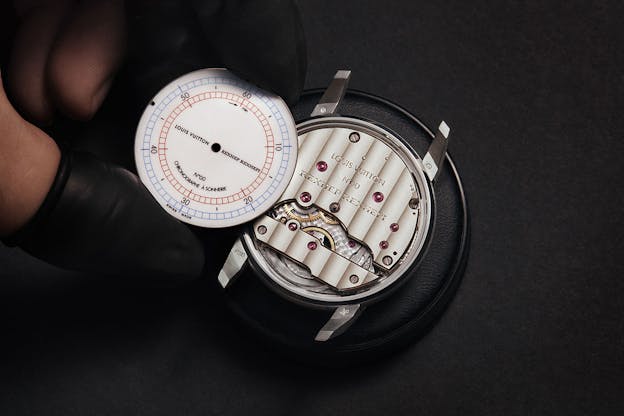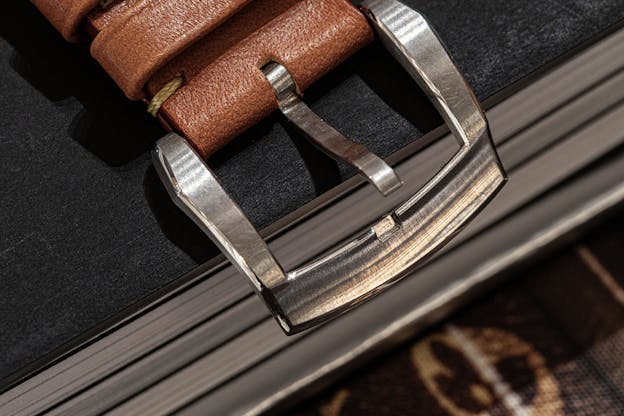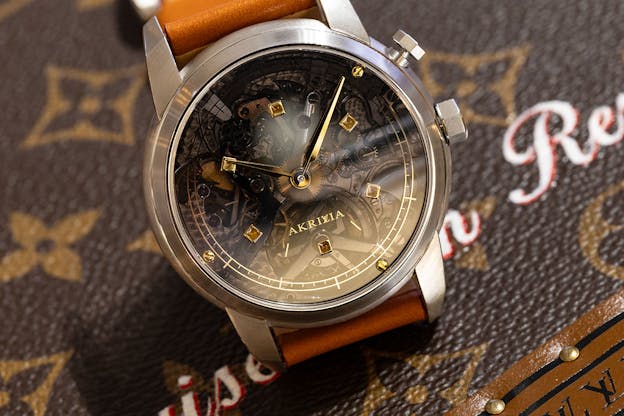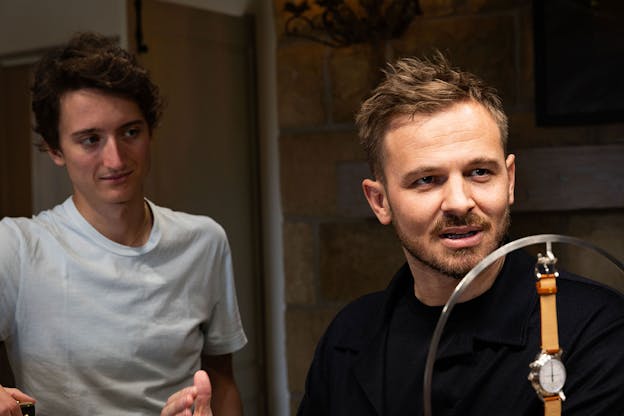The Akrivia X Louis Vuitton LVRR-01 Chronographe à Sonnerie
Rexhep Rexhepi doesn’t like collaborations, but that didn’t stop his partnership with Louis Vuitton from producing a marvelous watch.
The watch world has been awash in collaborations – good, bad, and everything in between – for so many years that it sometimes seems as if there are more collaborations (and limited editions) than there are good old fashioned production watches. Rexhep Rexhepi has gone on record as having a general distaste for them. In a recent interview with the Financial Times, he said, “I’m not a big fan of collaborations like that.” But despite his misgivings, the 36 year old watchmaker’s gone ahead and done it, partly thanks to Louis Vuitton’s watch director, Jean Arnault, whose real passion for watches and watchmaking was enough to convince Rexhepi that at the very least, the collaboration wouldn’t lack for genuine commitment.

The result is a watch unlike anything Rexhep Rexhepi and Akrivia have ever done, and it’s also unlike anything that Louis Vuitton has ever done. The brief was relatively straightforward: Take the Tambour case as a point of departure, and create a watch that reflects both the character of Akrivia and that of Louis Vuitton watches. Akrivia basically consists of two collections – Collection Akrivia itself, which tends to focus on more unusual designs and complications, and Collection Rexhep Rexhepi, which concentrates on more classical watchmaking and watch design codes.

The new LVRR-01 is a tourbillon, with chronograph, and sonnerie function. Each of these is unusual in some respect.
The Five Minute Tourbillon
First of all, there’s the tourbillon. Akrivia has specialized in tourbillons since its inception, and has to its credit a monopusher tourbillon chronograph, as well as an hour striking tourbillon with jumping hours, but this is the first time that Akrivia has done a five minute tourbillon. The overwhelming majority of tourbillons made today rotate once per minute, which in addition to being more or less the industry standard, also allows you to use the tourbillon cage as a seconds hand (either by attaching a hand to the upper pivot, or simply by designing the cage so that one arm is sufficiently visually distinct from the others to act as an indicator).

However, there is no particular unbreakable law of mechanics or watchmaking that says you can’t have a tourbillon that rotates slower, or faster. De Bethune does a thirty second tourbillon, for instance; Breguet, during his lifetime, created four minute tourbillons. One of the earliest known tourbillon wristwatch movements, the Omega 30 I, used a tourbillon that rotated once every seven and a half minutes and there are arguments for either approach. A high speed tourbillon rotates the regulating components through a full cycle of rotation faster than a slower one, obviously, but from a chronometry standpoint, this means those components (the balance, balance spring, escapement and escape wheel) spend even less time in any of the more extreme positions. The downside is that since the rotational period is very rapid, there is all this being equal, more inertia to overcome whenever the escapement unlocks and the tourbillon rotates. You can mitigate this to some extent by using lower inertia components made of materials like titanium and silicon.
The other option is to use a slower rotational speed, which still provides the benefits of a tourbillon but with a lower – sometimes much lower – inertial load, which means less energy drained when the escapement unlocks, since the cage turns through a smaller distance. This was the approach Omega favored (among others) in its wristwatch tourbillons and it’s the one that Akrivia used for the the LVRR-01, which has a five minute tourbillon. Rexhepi himself said at the launch event this week in Montecito, that he felt that from a chronometry standpoint, a slower rotational speed provides better results in general.
The Central 60 Minute Chronograph And Striking Mechanism
The movement is organized so that the most complex parts of the mechanism are on the dial side, which is a little bit of a departure from standard practice; generally, chronograph works are on the back (what a watchmaker would call “top plate”) side of the movement. The striking works are on the dial side as well and as a result, though the owner will never see it, the movement as seen from the back of the watch has a relatively straightforward appearance.

The chronograph is a central chronograph design; both the chronograph seconds hand and the chrono minute hand are on the same axis as the minute and hour hands for telling the time (which are on the opposite side of the movement). This arrangement is unusual although not unheard of – De Bethune’s Maxichrono has five hands on a single axis (hour, minute, and chronograph hour, minute, and seconds hands) and the Agengraphe caliber, as seen in watches by, among others, Singer, Ming, and Moser, whose Streamliner chronograph is a four-hander.
The dial on the back is in grand feu enamel, with the gold base disk produced at Akrivia and the enamel work done at La Fabrique du Temps, by their in-house enamelist, Nicolas Doublel. The design is an homage to Louis Vuitton’s first wristwatch, the Monterey, from the 1980s, which is enjoying some renewed interest in the current vintage market – it was relatively unknown and a bit obscure, unless you were a die-hard LV fan, for many years, but they have been showing up lately on the wrists of some major celebrities

On the dial side, there is quite a lot packed in under the semi-transparent sapphire dial. The dial, incidentally, is also a subtle shout out to the codes of Louis Vuitton watch design – the translucent markers, which are cubes filled with translucent plique-à-jour enamel, are an echo of the time cubes LV uses in its Spin Time range of timepieces.
Under that dial you’ll find the chronograph, tourbillon, and the striking mechanism, as well as the circular gong on which the minutes strike while the chronograph is running.

The tourbillon is visible at 6:00, and features a free-sprung balance with adjustable timing weights on the rim of the balance. The column wheel, for controlling start, stop, and reset, which are actuated via the single pusher at 2:00, is visible at about 11:00, and to the left of the center of the dial is the lateral clutch lever, which engages and disengages the chronograph.
Although the visual impact of the movement is somewhat muted by the smoked sapphire crystal (by design, of course) the level of movement finishing is exactly what we have come to expect from Rexhep Rexhepi, which is to say, it’s a emphatic expression of the intrinsic value of traditional fine hand finishing.

The watch has two mainspring barrels, one of which, per Akrivia and LV, drives the chronograph and the timekeeping train; the second barrel is responsible for actuating the chimes, once per minute. Since the chronograph is a 60 minute chronograph, the gong is struck sixty times over the course of an hour. This consumes a considerable amount of energy – a minute repeater, for instance, when it strikes 12:59 (the longest chime) will strike 12 times for the hour, six times for the quarters (there are two notes for each quarter, you might recall) and then 14 times for the minutes. That’s a total of 32 strikes so the energy consumption for the gong in the LVRR-01 over the course of an hour is nearly double that of a minute repeater, albeit the energy expenditure is spread out over a longer period.

Still, if the strike train drew energy from the going train (that is, the main timekeeping train) and mainspring barrel, you would have a regular spike in torque demand once per minute and of course, one critical property of a precision mechanical timekeeper is that there should be, ideally, as little variation in energy reaching the escapement and balance as possible. To address this problem, chiming watches usually have a second barrel just to power the chiming works. The LVRR-01’s second mainspring barrel doesn’t turn until the chronograph is activated, at which time the energy from the second barrel is used to arm and then release the hammer (the foot of the gong is at 3:00 in the image above, and the hammer is just below). The strike train is locked and released by a star-shaped wheel held in place by a ruby pallet, which is visible at 9:00.
The Case, Dial, And Overall Design
The LVRR-01 is a highly complex watch with an equally complex design language. The case is a highly modified Tambour design, and Rexhepi and Jean Arnault both said at the presentation of the watch, that while the basic design was established fairly early, there were some five or six variations tried before they settled on the final design. At 39.9mm x 12.2mm, the watch is thick for its width however, the thickness does not result in an uncomfortable wearing experience – this is partly thanks to the sharply angled lugs – and of course, a watch this complex, with two enamel dials (well, one sapphire with enamel decoration) is not going to be an exercise in ultra-thin watchmaking. The official figure of 12.2mm, by the way, was given at the presentation as the thickness of the prototype but for the series, Rexhepi says he will be able to reduce the thickness a bit more, perhaps to under 12mm.

The case, in the prototypes we saw, was brush finished and the shape of the case and lugs emphasizes the mass and subtle luster of the material. The lugs are soldered in place and the overall impression you get is of a highly concentrated, almost ingot-like object. The angular shape of the lugs helps to break up the rotundity of the case design and both the shape of the lugs and the buckle reflect, and contrast with, the case design.

The first impression I got of the watch was of something relatively compact, with a great deal of complexity packed into a relatively small amount of space; these complications from other watchmakers and other brands, would probably have been perhaps thicker and almost certainly wider. There are a combination of design cues with a broad range of references and connections – to the Tambour case design, of course, but also to the first Louis Vuitton watch, to the Spin Time complication, and of course, to Rexhep Rexhepi’s own very diverse family of complications and designs.
This does feel like an Akrivia collaboration specifically (inasmuch as the watches in the Akrivia family are mostly tourbillons and generally both complicated mechanically and aesthetically) and the combination of Akrivia and Louis Vuitton aesthetics feels very balanced. This is a well known fact, but still, it bears mentioning that platinum is an absolute bear to machine and the complex case, crown, pusher, and soldered lugs represent considerably more time, energy and effort than would be expended on a steel or gold alloy case.

It is, not coincidentally, a challenging watch to photograph thanks to the combination of slightly warm colors, the cool gleam of mechanical components underneath the smoked sapphire dial, and the combination of opacity and reflectiveness of the sapphire dial itself. The components under the dial do exhibit very classical fine watchmaking finishing but thanks to the high level of polishing, they also reflect the darkness of the dial and the upper surfaces of the steelwork take on a dark grey, almost black coloration.
If there is any one aspect of the design I wonder about, it’s that smoked sapphire dial. The components are somewhat obscured by it, although as I’ve mentioned, this is by design and when the watch is operating (the prototypes we were shown were not running) the kinetic effects of the tourbillon and, when running, the chronograph and chronograph minute strike train, might give a very different impression. If I were involved in giving input between the late prototypes shown here, and the final production watches, I would probably ask to try different levels of opacity in the crystal – not out of any conviction at this point that the darkness of the dial is an impediment to appreciating the watch, but rather, out of genuine curiosity over how adjusting the dial’s opacity might affect the impact of the watch; at this level of watchmaking and level of design, every detail matters.


The enormous resources of LVMH and Louis Vuitton encourage some understandable skepticism about the bona fides of the collaboration. However, I don’t think this collaboration came about as a result of it fitting some largely marketing and revenue driven strategy; a project like this, for all that the watch is expensive, is not a revenue source that would make a particle of difference to LVMH’s bottom line.
Interviewed for the FT’s article on the collaboration, Michael Tay, managing director of The Hour Glass in Singapore, had this to say:
“According to Michael Tay, that personal relationship is crucial to understanding the true nature of the collaboration. ‘Fundamentally, Jean’s a product guy. This is something that would have motivated Rexhep. It is not just a brand that Rexhep is collaborating with, it is another passionate individual. If Jean was not there, I’m not sure Rexhep would have pulled the trigger on this project.'”

Louis Vuitton has mentioned that this is the first time an LV collaboration has resulted in a change to the LV logo – this is not the first LV collab (comments elsewhere have mentioned, for instance, Louis Vuitton’s collaboration with Supreme) but it is as far as I can tell, the first time the LV logo itself has been altered (and I asked; it’s pronounced “Ah-KRIL-vee-ah”).
This is a watch that I think reveals itself slowly – certainly, over a longer period of time than the half a day we were able to spend with it at launch. It is the product of considerable care and thought and while you ought to be able to expect this level of craft and real horological content in a half million dollar watch, it can happen that you can spend that amount of money and not actually get a lot of real horological content for your money. In the LVRR-01 I think we have a watch that will repay longer acquaintance with an increasingly rich experience – a piece of fine watchmaking which will provide, not increasing disappointment as time goes by, but increasing pleasure.
All photos, Louis Vuitton/Piotr Stoklosa, except where noted. The Louis Vuitton x Atelier Akrivia LVRR-O1 Chronographe à Sonnerie: case, platinum, 39mm x 12.2mm, sapphire crystals front and back; water resistance, 30 meters. Dials: front, smoked translucent sapphire with six gold cubes filled with plique-à-jour enamel; 3N rose gold railway track and logo; back, grand feu enamel on a platinum-gold base. Movement, LVRR-01, central hours and minutes, 5 minute tourbillon with 60 minute monopusher central chronograph, chiming once per minute while the chronograph is running; 72 hour power reserve and running in 41 jewels at 21,600 vph. Platinum pin buckle. Limited edition of 10 pieces worldwide; price, CHF 450,000. Find out more at Akrivia.com.


